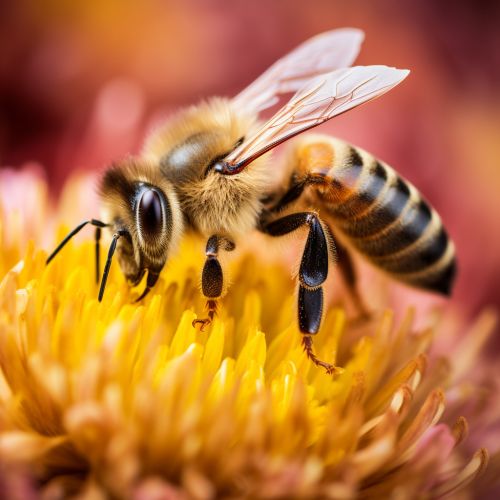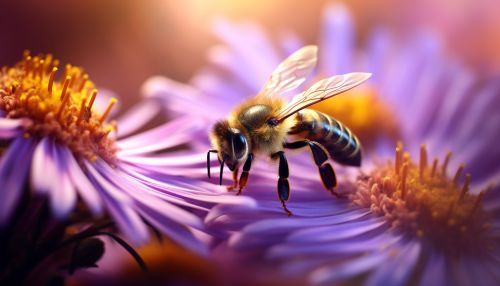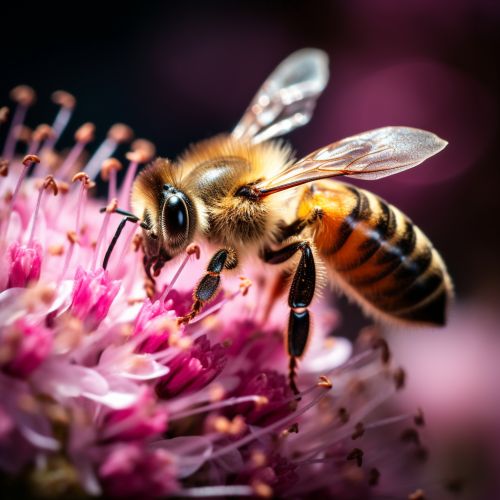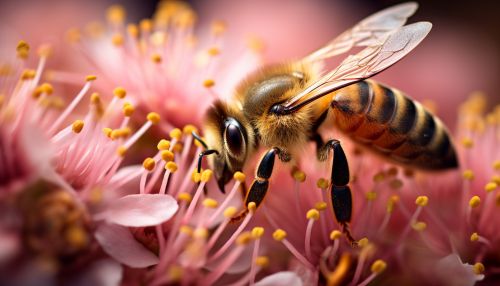Honey bee behavior
Introduction
The Honey bee (Apis mellifera) is a eusocial insect that exhibits a range of complex behaviors. These behaviors are primarily driven by the bee's role within the colony and are influenced by environmental factors, genetic makeup, and the bee's physiological state. This article delves into the intricacies of honey bee behavior, exploring aspects such as communication, foraging, reproduction, and defense mechanisms.


Communication
Honey bees are known for their sophisticated communication system, which involves a combination of chemical, tactile, and visual signals. The most famous aspect of this system is the 'waggle dance', a unique form of communication used by forager bees to inform their hive mates about the location of food sources.
Waggle Dance
The waggle dance is a figure-eight dance performed by forager bees to communicate the distance and direction of a food source to other members of the colony. The dance consists of a straight run (the 'waggle phase') followed by a return phase. The duration of the waggle phase indicates the distance to the food source, while the angle of the dance relative to the vertical indicates the direction.
Pheromones
Pheromones play a crucial role in honey bee communication. These chemical signals are used to relay a variety of messages, from alarm signals to queen presence. The queen bee, for instance, emits a specific pheromone known as the 'queen substance', which regulates the behavior of worker bees and maintains the social structure of the colony.
Foraging Behavior
Foraging is a vital activity for honey bees, as it allows them to gather the nectar, pollen, water, and propolis necessary for colony survival. This behavior is influenced by a variety of factors, including the bee's age, the needs of the colony, and environmental conditions.
Division of Labor
In a honey bee colony, there is a clear division of labor among worker bees. Younger workers, known as 'house bees', perform tasks within the hive such as cleaning, feeding larvae, and processing food. As they age, these bees transition to foraging duties, venturing outside the hive to gather resources.
Nectar and Pollen Collection
Nectar and pollen are the primary food sources for honey bees. Forager bees visit flowers to collect nectar, which is converted into honey within the hive. During these visits, bees also collect pollen, which is packed into 'pollen baskets' on their hind legs and transported back to the hive. This pollen serves as a protein source for the colony and is particularly important for larval development.


Reproductive Behavior
The reproductive behavior of honey bees involves a complex interplay between the queen bee, drone bees, and worker bees.
Queen Bee
The queen bee is the only sexually mature female in the colony and is responsible for all egg-laying. She mates with multiple drones during a brief mating period early in her life and stores their sperm for use throughout her lifespan. The queen uses this stored sperm to fertilize eggs, which develop into worker bees or new queens. Unfertilized eggs develop into drones.
Drone Bees
Drone bees are the male bees in a honey bee colony. Their primary role is to mate with a virgin queen bee. Drones are produced from unfertilized eggs and, as such, they are haploid and possess only the genetic material of their mother.
Worker Bees
Worker bees are sterile females that perform the majority of tasks within the colony. However, in certain circumstances, such as the absence of a queen, worker bees can lay unfertilized eggs that develop into drones.
Defense Mechanisms
Honey bees employ a range of defense mechanisms to protect their colony from threats. These include stinging, alarm pheromones, and defensive buzzing.
Stinging
The sting of a honey bee is a potent defense mechanism. When a bee stings, it leaves its stinger and venom sac behind, causing the bee to die. This act of self-sacrifice is a form of altruistic behavior, as it helps protect the colony.
Alarm Pheromones
When a honey bee stings, it releases an alarm pheromone that alerts other bees to the threat. This pheromone triggers aggressive behavior in other bees, causing them to sting the intruder as well.
Defensive Buzzing
Honey bees also use sound as a form of defense. When threatened, bees produce a high-pitched buzzing sound, known as 'buzzing run'. This behavior is thought to be a warning signal to potential predators.
